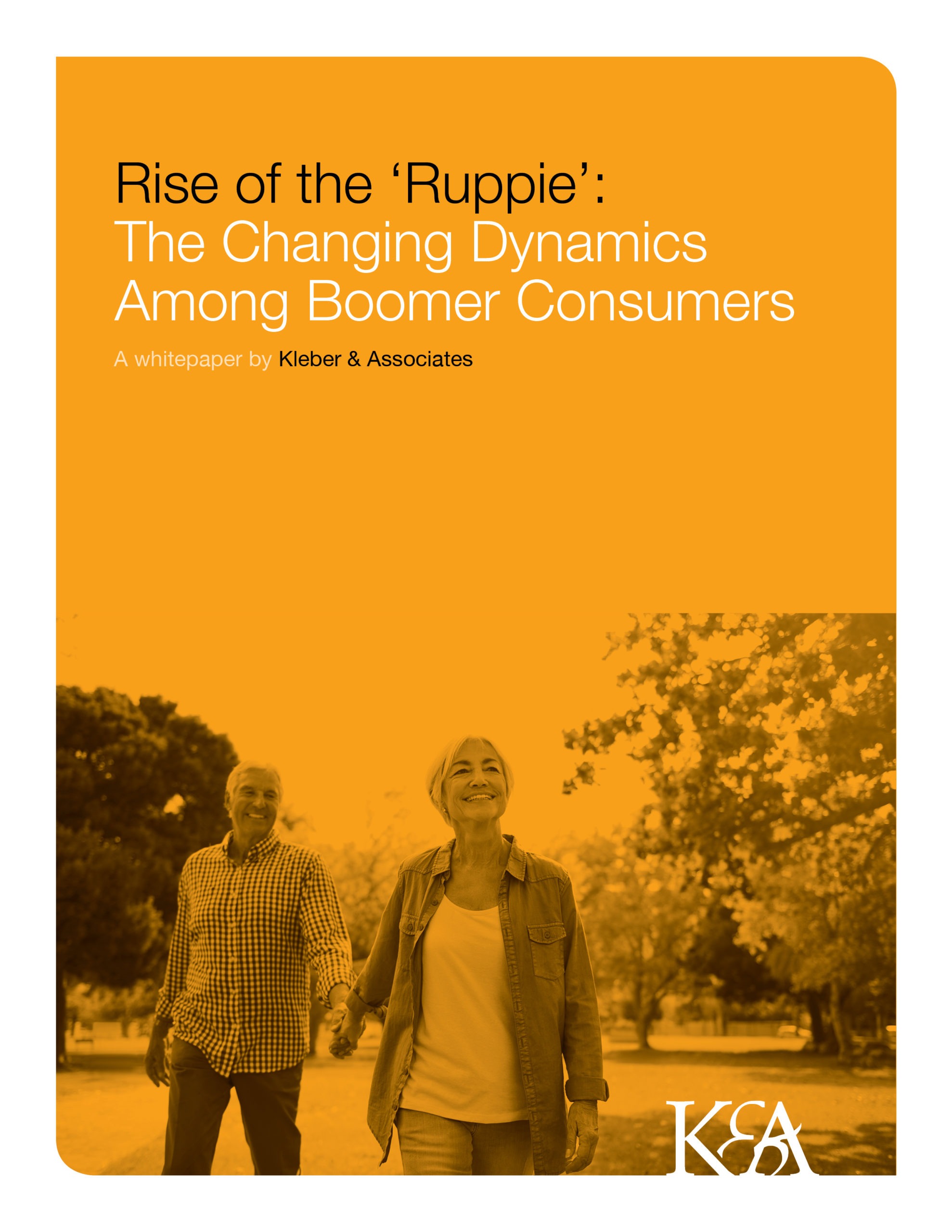Rise of the ‘Ruppie’: The Changing Dynamics Among Boomer Consumers
A white paper by Kleber & Associates
While politics take the spotlight as we near the election, the housing channel continues to surge – with sales of existing homes rising to approximately six million units in August, year-to-date. New homes sales exceeded one million this year – the highest number since 2006, despite sales constraints due to lack of inventory.
Cheap mortgages are influencing this trend. However, thanks to tighter credit standards among mortgage lenders and ongoing wage stagnation, it is more difficult for up-and-coming millennials to form households. That problem is combined with a mix of newly built homes that leans toward the larger and more expensive, creating a market favorable to older buyers.
Boomers 2.0
Baby boomers (persons born between 1946 and 1964) emerged after the end of World War II, when birth rates across the world spiked as a result of prolonged economic confidence and stability. The explosion of new infants during that time (almost 77 million babies were born in the United States alone) became known as the ‘baby boom.’ At the time, baby boomers comprised nearly 40 percent of the American population and influenced American consumer habits for decades, as larger families populated the suburbs aided by programs like the G.I. Bill.
The generation that helped define American consumerism is doing so again. The first time, it was as confident, virile young people with large families and a desire to acquire large homes and consumer goods. This time, it’s as retirees. According to Lori Bitter, author of “The Grandparent Economy,” the majority of the consumer marketplace is over the age of 50.
The first of the baby boomers became eligible to retire in 2012 and in many ways, their post-work years are shaping up to be very different than that of their parents, the Greatest Generation. As baby boomers are living longer, retiring later, and assuming the role of active grandparents during the COVID-19 childcare crisis, many are opting for customizable living arrangements with better amenities and access to city centers rather than the quiet, remote, cookie-cutter retirement communities of the past.
As Bitter states in her book, a confluence of economic and health trends – including greater access to and understanding of technology via the Internet – is creating younger, “hipper” consumers in the 50+ demographic. These people have come to be known as “ruppies” or “retired urban professionals.”
Coined by author Kyle Ezell, the term, ‘ruppie’ describes older adults who are turning upside down the traditional view of one’s “golden years.” The age of 40 was once considered ‘over the hill,’ but today, people are getting married and having children later in life and are – in general – slower to retire. A significant number of today’s mature adults (many of whom are “empty nesters”) are abandoning large, single-family homes and opting instead for an urban oasis close to the action of city life that is within walking distance to coffee shops, public transportation, retail stores, parks, restaurants and other amenities.
Marketing efforts are typically focused on the young because youth consumer behaviors are often easier to predict – people in their 20s typically want to party, live their best lives, and purchase high-end fashion goods. People in their 30s are starting to settle down and establish homes and families while people in their 40s and 50s, having established themselves, are thinking about investments and more considered purchases.
That formula is changing, however, as more households include multiple generations living under the same roof, and relationships are focusing more on shared values and interests rather than age groups. Ruppies are interested in remaining active and integral to what’s happening around them rather than finding a quiet place to retire among their peers. Building product manufacturers need to be aware of this changing dynamic – and the benefits of marketing to ruppies – when they allocate their advertising dollars.
Ruppies: Not Quite Their Counterparts
The joyfulness of the Roaring Twenties was short lived in comparison to the devastating and lasting effects brought on by the stock market crash of 1929.
Afflicted by wars, financial instability and social inequalities, the parents of boomers (referred to as the Greatest Generation) lived quite differently than their offspring. Austerity and modesty were the norms for the WWII generation during the strain of the Great Depression. Inadequate healthcare and insufficient nutrition limited the average life span, significantly influencing life plans. While this generation eventually overcame societal distress, it continued to be risk averse… adopting a conservative way of life.
Older adults of yesteryear were diligent in their retirement planning. Following the status quo, they typically retired between ages 55 and 70. Quiet, peaceful retirement communities attracted senior citizens in search of rest and relaxation. As noted by author George Moschis, Ph.D., however, there are considerable differences between baby boomers and their parents regarding concerns and preferences around money, leisure time, health, aging and activities of daily living.
Baby Boomers: Redefining America
The sudden surge in births that gave rise to the ‘baby boom’ was evidence of a shift away from the economic and social restraints that prohibited WWII-era couples from having children and starting families. Boomers’ collective cultural identity includes momentous events such as the Vietnam War, the assassinations of President John F. Kennedy and Martin Luther King Jr., the Watergate scandal, the emergence of birth control, and the ‘free love’ movement. This generation was inspired to rebel and question authority with war protests and peace demonstrations.
With life expectancy at an all-time high, it comes as little surprise that ruppies are not ready to slow down or put their dreams to bed. Many seek to live out their dream of wanting to own a mom-and-pop restaurant or other small business after fulfilling their traditional career path. On the other side of the coin, fewer boomers have traditional employer-sponsored pensions to support them and many are choosing to work and stay active as long as they can. According to a recent study by the Insured Retirement Institute, only 25 percent of people in the age 55 to 71 age bracket plan to retire earlier than age 65, and 29 percent expect to work past age 70.
What’s more, a large percentage of the 73 million American boomers are expected to live 10 to 25 years longer than their parents did. Those retiring in their 60s can expect to live about 25 years more, at least, so their retirement period will be longer. New advancements in technology and research have forged invaluable improvements in health and medicine, while treatment options and pharmaceutical choices have never been better… and are attributed to prolonged well-being. Ready to enjoy an extended lease on life, many ‘mature’ adults are reassessing their dreams and goals and reinventing them accordingly.
No longer defined by their occupations, ruppies seek meaningful connections in the communities in which they live. They are not suffering through a mid-life crisis. Rather, they are enjoying a fresh outlook without the restraints and limitations imparted by child-rearing and employer demands. Ruppies want to enjoy the ultimate freedom and live it up.
Lifelong Learners: Achieving Self-Actualization
In Maslow’s hierarchy of needs, self-actualization has remained one of the more elusive human accomplishments. It can be difficult to obtain if all other prerequisite needs, such as social needs, safety needs and esteem needs are unmet. But, with the newfound free time retirement affords, the goal of self-actualization can be achieved in a variety of ways.
On the quest to reach their true potential, many retirees are becoming students once again. Whether they’re looking to sharpen their skills, change careers or be intellectually stimulated… many boomers are attracted to adult learning opportunities. Several colleges and universities allow retired adults to audit classes for nominal fees or no cost at all. Retirees are increasingly taking advantage of these programs, causing some universities to limit the number of retirees who can take popular courses.
A growing number of retirement communities have negotiated arrangements with nearby campuses as one of the benefits of living there. At Boston University, seniors 58 and older can audit classes through the college’s Evergreen program, which offers individual seminars for $30 each or $150 for multiple seminars. Free courses are offered to older adults at colleges like Pomona College and Penn State, while others states such as Virginia and Minnesota incentivize seniors to audit classes.
Societal Impact
Conventional wisdom leads us to believe that volunteering peaks after retirement, when people have more time to devote to such activities. And, because education and wealth have traditionally been accurate indicators of society’s cultural appreciation, it is reasonable to surmise that boomers will be significant supporters of the arts and participants in community service efforts. After all, this group holds the nation’s largest share of wealth and is highly educated.
Harvard’s School of Public Health conducted a report titled “Reinventing Aging: Baby Boomers and Civic Engagement,” which points to boomers’ potential to have an impact of unprecedented proportions by actively engaging in their communities. The study discusses the need to stimulate a public dialogue that will encourage boomers to reflect on the meaning and purpose of their later years. To support this push, the entertainment and advertising industries are increasingly portraying aging in more favorable ways. Images of frail, dependent elders will continue to be replaced by those showing vivacious, healthy and eternally young individuals.
Proponents of the potential for positive societal impact, several non-profit firms are seeking to lure boomers into volunteering. Organizations like AmeriCorps Seniors and sites like www.retiredbrains.com have experienced a rise in popularity that is expected to continue.
Changes in the American Workforce
Some fear an impending mass exodus of boomers from the workforce. However, for many Americans faced with ever-increasing financial demands and rising healthcare costs, retirement is not an option. For those who are able to do so… it is a luxury.
While some baby boomers will imitate their predecessors by exiting the workforce and living a life of leisure, others will remain working in some capacity. Due in part to the current economic uncertainty and the fact that boomers are generally healthier than the previous generation, they are continuing to remain an integral part of the workforce – about five to 10 years past the typical retirement age of 65.
On another level, Americans are increasingly becoming concerned that they will outlive their retirement savings and are making the decision to postpone retirement or become semi-retired while continuing to work part-time. Half of American families in the 56-to-61 age bracket had less than $21,000 in retirement savings in 2016, according to a longitudinal study by the Economic Policy Institute. A survey in 2019 found that 40 percent of Americans over the age of 60 who are no longer working full-time rely solely on Social Security for their income—the median annual benefit is about $17,000.
According to recent data from the U.S. Bureau of Labor Statistics, about 27 percent of workers ages 55 and older worked part-time (up to 34 hours per week). For workers ages 65 and older, the rate of part-time employment is even higher at 40 percent.
These statistics are punctuated by the fact that many have been forced to pull funds from their retirement due to COVID-19. According to Newsweek, more than half of Americans have taken money out of their retirement savings accounts to cover basic expenses during the coronavirus pandemic. Moreover, many employers have halted contributions to their retirement accounts during the past year, further jeopardizing boomers’ financial security after retirement.
Businesses are increasingly absolving themselves from responsibility and are instead shifting the burden of risk to employees. To address this national concern, the White House has introduced Automatic IRA legislation to improve the outlook on retirement for all Americans. For many boomers, the current economic crisis has them looking at an extended career tenure.
Differences Between Boomers and Ruppies
Not all boomers fall into the ruppies category. First, retirement or lack thereof differentiates the two groups. Second, for those who have retirement as an option, they may not share the ruppies’ desire for an urban lifestyle. Boomers are liberal and conservative, rural and urban, blue collar and white collar. They often prefer traditional single-family homes to ruppies’ downtown developments.
According to a National Association of Realtors (NAR) study, boomers may want or need a larger dwelling that includes one or two home office settings. The study also points out that a low maintenance home on a single level has broad appeal to this group. For those boomers that do ‘downsize’ to a smaller home, they aren’t forsaking quality. They often move into homes that offer maximum comfort and ease yet are plush pads laced with the latest amenities. It’s safe to say that ‘traditional’ boomers still have a huge influence in the remodeling and home buying market and will continue to shape and drive the future of the housing marketplace.
According to NAR study findings, 60 percent of boomers expect to live in their current residence during the next five years; 65 percent intend to remodel or improve their homes; 42 percent of all home improvement projects will be done by outside contractors; and 77 percent believe that the way their home looks is important to who they are. Considering that 75 percent of boomers are homeowners (compared to only 32 percent of millennials), it’s wise to target this leading attitudinal group.
In the case of remodeling, these individuals are looking to make improvements in their home to sustain and improve the resale value and enhance their quality of life as they age, specifically in their kitchens, as boomers (as do most homeowners) deem it the most important room of the home.
For ‘traditional’ boomers who don’t prefer urban living, cities like Fairhope, Alabama pose an attractive option that boasts southern hospitality and the joys of coastal living. The quaint town of about 13,000 is a golfer’s dream and offers the peaceful lifestyle many retirees prefer. Not surprisingly, Fairhope has been on numerous lists for top places to retire in the U.S.
Ruppies’ Desire for Urban Living
The Seniors Housing Council cites the 1960s as the era when America was first introduced to active-adult communities. Traditionally located in ‘Sun Belt’ states, these communities were large in size and shared similar formats, designs and amenities. Fast forward to the new millennium and active-adult communities are a far cry from what they once were. Today’s active adults intentionally avoid cookie-cutter homes and instead seek places where they can express their individuality.
Although typically considered a ‘hipster’ scene, downtown areas are experiencing a renaissance of sorts… attracting city dwellers from all walks of life. Urban areas have all the amenities ruppies seek – access to culture, medical services, restaurants, shopping, fitness and entertainment. Ruppies flocking to downtown areas wish to experience a heightened quality of life paired with hassle-free living, including shorter commutes, easy access to public transportation, an array of activities from which to choose, limited house upkeep and maintenance and no yard work.
Many wonder why they didn’t make the move sooner. According to AARP, retirees who cross state lines do so to live closer to family members rather than to reap the benefits of better weather, tax relief or for a new adventure.
Iowa State University notes that the shift from suburbia to urbanism is evident as cities revitalize their downtowns and surrounding neighborhoods. Indeed, many downtown areas are experiencing revitalization as a result of the new influx of people in varying stages of life, from college to retirement years.
According to the Wall Street Journal, “It’s a new era for the condo, once viewed as the stepchild of the housing market. Condos leapt to prominence after the 1961 Housing Act, which enabled the Federal Housing Administration to insure mortgages on the units. In those days, the properties were simple and affordable, a starter home for first-time buyers whose dream was to own a more substantial home in the suburbs.”
Meeting Ruppies’ Housing Needs
The Wall Street Journal reports that, “Unlike the drab structures of yesteryear, many newly constructed condos are plush abodes, containing the kinds of amenities found only in the most upscale suburban developments, such as marble bathrooms, gourmet kitchens, tennis courts, swimming pools and health clubs. High-end features such as broadband access are also becoming standard. Many new units are larger than those of the past.”
The National Association of Home Builders’ (NAHB) annual Best of 55+ Housing Awards (which honor excellence in the design, development and marketing of housing for older consumers) pay homage to active adult communities, lifestyle communities and more traditional senior housing. The Trilogy® in Summerlin community in Las Vegas, Nevada won 2020 Community of the Year for its innovative approach to active-adult living.
A true town center, with designer shopping, boutiques and signature dining less than three miles from the community, Trilogy in Summerlin features a variety of indoor and outdoor amenities, including a culinary kitchen, second-floor sports and media deck, resort-style pool, fully equipped fitness center and movement studio, dog park, Zen garden, pickleball and bocce courts, event and meeting space, and more.
Many American cities already have the resources in place to support ruppies in their transition from suburbia to downtown. These programs and services, which include public transportation systems, expanded sidewalks for walking, improved healthcare and a wide range of mixed-use housing – make cities such as Atlanta, Portland and Boston easily livable.
Marketing to Ruppies
Seventy-seven million baby boomers came of age with television – America’s first mass market and an advertiser’s dream. As kids, they were consumers of baby foods and breakfast cereals. As adults, they were trendsetters. But as they outgrow the desired 18-49 demographic, they are creating a new frontier for marketers.
Baby boomers presently make up the lion’s share of the political, cultural, industrial and academic leadership class in the U.S. There is also a wide, often diverging, spectrum of values and attitudes espoused by American’s largest generational group. To date, baby boomers also have the highest median household incomes in the U.S.
While Ruppies are aging in years, they manage to maintain a youthful attitude and optimistic outlook. What’s more, they are still spending money, and lots of it.
According to AARP, the over-50 population controls almost 80 percent of U.S. aggregate net worth. The average wealth of households headed by people over 50 is almost three times the size of those headed by people aged 25 to 50. People over 50 contribute on average $3 trillion to consumer spending, excluding healthcare, representing approximately 51 percent of spending by all over-25 consumers.
As a group, ruppies are likely to be vigorous consumers as they empty the nest, take on new jobs, relocate, support children they had in their 40s, go back to school, start a second or third career, remarry, inherit money from their savings-minded parents, pursue new hobbies and tackle the health issues of aging. Marketers are slowly waking up to ruppies’ enormous economic clout.
This demographic is padding their bank accounts, thanks to peak earning years and a longer career span. Plus, many are reporting greater financial freedom since they are no longer paying for children’s tuition, cars or other expenses. They are engaged in living and learning and are increasingly technologically savvy, particularly in the area of computers and the Internet.
With a grip on 80 percent of the nation’s wealth, this demographic is too vast and too wealthy to neglect. Despite their clout, an AARP survey indicates that 27 percent of these consumers acknowledge that they are poor financial managers as a result of time constraints, the complexity of choices and the wide array of options available. When it comes to product and service explanations, there is considerable room for improvement.
On account of their sizeable purchasing power and lack of brand loyalty, some marketers have coined this cohort ‘Generation Buy’ and ‘Promiscuous Purchasers.’ Unfortunately, less than 10 percent of ad campaigns are targeted to this lucrative group. Recent studies identified that marketers continue to alienate boomers by over generalizing and misrepresenting them.
Trailblazing Companies Tapping into Ruppies
To attract ruppies’ disposable income, smart companies are rethinking their sales and marketing approach. Boomers’ generational icons such as Tom Selleck and William Shatner are becoming familiar faces in marketing messages targeted to this audience. Canadian model Maye Musk was contracted several years ago as a Cover Girl model at the age of 69, showing that beauty is not defined by age.
Some advertisers have even romanticized the era previously frowned upon by the majority of society. Not too long ago, GEICO launched an advertising campaign with a tongue-in-cheek message, ‘Survive the 60s?’ This ad and others are a throwback to the so-called hippie generation. While some may deem the messages as controversial, they are nevertheless highly relevant to the target audience and, as such, much more likely to be provide sales dividends.
Ruppies seek comfort in the form of safety, guarantees and experience. As a result, organizations should consider incorporating better warranty information, company history and financial prowess into marketing messages.
Boomers in Favor of Aging-in-Place
For those who can afford to maintain their current standard of living in their existing homes, staying in place is a no-brainer. After all, they already have attachments to the community around them after years of residing in the same community.
Since the boomer generation is considered more active, wealthy and educated than generations of years past, concerns of limited mobility are sparse. Independent living is more attainable and for a longer period of time. However, succumbing to a homebound lifestyle is more accommodating than ever.
For retirees who opt to stay at home and age in place, consider how companies such as Home Instead Senior Care provide much needed assistance. The Omaha-based company provides shopping, cooking and cleaning services for seniors and has expanded from 228 to more than 600 franchises in the U.S. since 2000.
Everyday living can be enhanced with the addition of universal design features offered in new construction and remodeling. First introduced by architect Ronald Mace, universal design improves the safety and utility of homes. In the 1970s, Mace and other architects developed seven universal design principles. The fundamentals include equitable use, flexibility in use, simple and intuitive use, perceptible information, tolerance for error, low physical effort and size and space for approach and use.
Universal design appeals to a large cross-section of age groups and compensates for reduced strength, mobility and agility, while aiding in balance and coordination. Handrails, enhanced lighting, wider doorways, levered handles, low-pile carpeting, zero threshold showers, stepless entries and other features are all designed to accommodate retirees who wish to live independently.
The movement toward universal design is steadily gaining momentum as evidenced by the NAHB’s Certified Aging-in-Place Specialist, or CAPS certification. This trend will continue to be at the forefront of home design for the foreseeable future.
Home Products for the “Near Retirement Age” Population
Whether a boomer resides in a suburban single family home or a ruppie lives in the heart of downtown, the 50-plus population can agree on one thing – the desire for enhanced amenities in their kitchens and baths.
Beginning with the kitchen, ruppie and boomer consumers look for adjustable countertops that offer added flexibility and convenience, pull-down shelving for enhanced access, natural flooring that reduces back and foot strain, under-cabinet task lighting and elevated dishwashers.
When it comes to the bathroom, motion sensory faucets, grab bars in the shower, bath and shower seating, lever handles, smooth countertop edges, along with higher placed sinks, vanities and toilets that offer superior ease and comfort… all attract this demographic.
Whether remodeling their suburban home or in-town condo purchase, boomers and ruppies alike are looking for universal design and product options that support ease of living with a special emphasis on quality and individual style.
Home is Where You Make It
For both traditional baby boomers and ruppies, it’s not where they live that matters, but instead…how they live. Some people achieve the highest quality of life in large, metropolitan cities, while others prefer the tranquility of traditional retirement communities. Some will remain engaged in the world around them and some will happily relinquish added responsibilities.
Progressive building product marketers need to offer alternatives to the narrow mindset that currently reflects society’s attitudes toward aging. To combat the negativity associated with aging, offer a fresh take that consumers haven’t seen. As the connection between age and retirement becomes increasingly vague, society at large will continue to turn to popular culture and the media to redefine how we look at our golden years. Wise marketers will make those years count.












